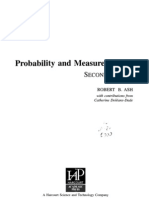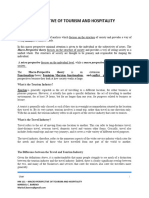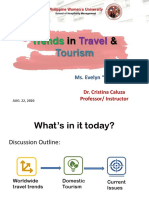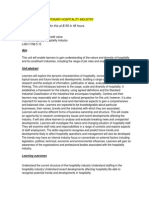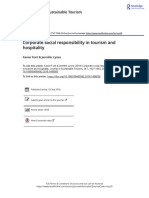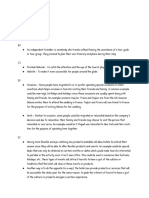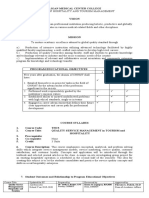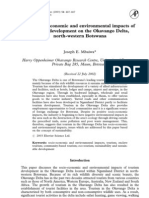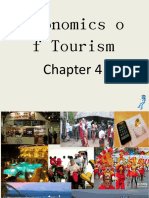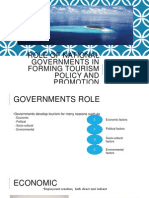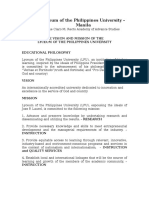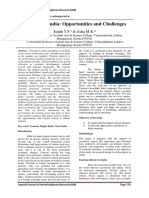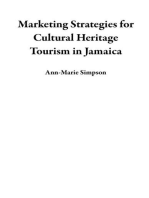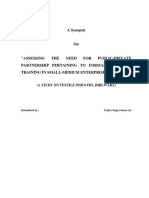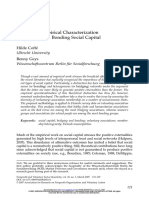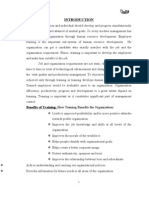Factors Influencing Destination Choice of Indian Tourists Visiting Abroad
Factors Influencing Destination Choice of Indian Tourists Visiting Abroad
Uploaded by
Son AdamCopyright:
Available Formats
Factors Influencing Destination Choice of Indian Tourists Visiting Abroad
Factors Influencing Destination Choice of Indian Tourists Visiting Abroad
Uploaded by
Son AdamOriginal Title
Copyright
Available Formats
Share this document
Did you find this document useful?
Is this content inappropriate?
Copyright:
Available Formats
Factors Influencing Destination Choice of Indian Tourists Visiting Abroad
Factors Influencing Destination Choice of Indian Tourists Visiting Abroad
Uploaded by
Son AdamCopyright:
Available Formats
Pramana Research Journal ISSN NO: 2249-2976
Factors Influencing Destination Choice of Indian Tourists Visiting Abroad –
An Analytical Study
Dr. Kunal Gaurav
Associate Dean (Strategic Research), ICBM – School of Business Excellence, Hyderabad -
500048, Telangana, India
Abstract
In recent past, the travel and tourism sector has emerged as one of the vital as well as fastest
growing sector across the world. The rising disposable income coupled with changing lifestyle of
Indians fuel the growth of Indian outbound travel and tourism. The Indian outbound travel and
tourism is on the rise as increasing number of Indian tourists are going to international
destinations. Marketers offering international tour packages always try to understand the pulse
of Indian tourists in order to offer wonderful tour and travel experience to them. In order to
predict future travel patterns of the tourists, it’s vital to gain knowledge of people’s travel
motivations and its association with destination selection. At this backdrop, the present research
study is designed with an intention to uncover the underlying factors that influence destination
choice of Indian tourists visiting abroad. Exploratory factor analysis was employed to extract the
underlying factors that are deemed to influence destination choice of Indian tourists visiting
abroad. This study also tries to capture the travel intention of Indian tourist with reference to
their interest associated with their foreign travel.
Key Words: Outbound travel, destination choice, Indian tourist, Factor analysis.
1. Introduction
Time is gone when people used to travel abroad mainly because of obligatory reasons such as
education, employment, therapeutic reasons etc.; today most of the people travel abroad for
leisure. In recent time, tourism has emerged as one of the fastest growing areas of the global
economy and its contribution to certain nation is phenomenal. In India, tourism sector is
economically important and is growing leaps and bound.
The Indian globetrotter (traveler) has emerged as one of the leading spenders who is being
wooed aggressively by the world for his big bucks. Rajeev D Kale, Thomas Cook (India)’s
president and COO, outbound tourism, said, “India is one of the largest outbound travel markets
globally. World Travel & Tourism Council’s Travel & Tourism Economic Impact 2014 (shows)
that the total expenditure on outbound travel in India was Rs 75,000 crore in 2013 and (is)
projected to be Rs 160,500 crores in 2024”1. It’s really interesting to note that United Kingdom
(UK) counts Indian tourists as the 14th largest spenders in different British tourist destinations. At
the same time, the German National Tourism Office (GNTO) opines that the Indian tourists are
the fourth largest spenders for them, in terms of expenditure per person, per trip. Every year,
1
http://timesofindia.indiatimes.com/business/india-business/Indian-travellers-among-biggest-spenders-
abroad/articleshow/52002855.cms
Volume 9, Issue 6, 2019 203 https://pramanaresearch.org/
Pramana Research Journal ISSN NO: 2249-2976
more than 5.4 million Indians visit international destinations for various reasons such as doing
business, attending meetings, honeymoon, sightseeing, shopping and especially meeting friends
and relatives. United Nations World Tourism Organization (UNWTO) estimated that the number
of Indians tourists heading abroad will grow to 50 million for both business and leisure travel by
the year 20202.
Today’s Indians are more likely to visit abroad for vacations in comparison with yesterday’s
Indians who used to prefer indigenous holiday destinations. Increasing GDP of India, growing
air connectivity, rise of low cost carriers, augmentation of urban middle class are some of the
noticeable factors that have contributed to the growth of Indian outbound tourism. Rising income
coupled with world class life styles often encourage Indian wanderers to shift their preferences
from standard group tours to personalized luxurious vacations. While traveling to the
international destinations, Indian tourists are among the world’s highest spending globetrotters.
According to a recent statistics, the spending power of Indian globetrotter is estimated to be four
times that of the Chinese and Japanese3. Travel industry professionals strongly feel that the
Indian middle class is on the move and set to fuel the global travel boom from Asia. According
to a recent statistics, Dubai, USA, Thailand, and Singapore are the top choices for Indian tourists
travelling abroad. The UK, Australia, Indonesia, Turkey, Oman, Sri Lanka and Maldives are the
other conventionally most visited international destinations by Indian tourists. In recent times,
countries such as Canada, Indonesia, Philippines, Mauritius, Jordan, Taiwan and Kenya are also
witnessing significant rise in receiving Indian tourists4.
Different people prefer to visit different destinations because of varied stated as well as unstated
reasons. Similar to all products and services, tourist destinations do strive for the limited time
and resources available at the disposal of the consumers (tourists). When an individual decides to
visit a specific destination, there must be some purpose that makes him / her to do so. The
marketers of tourist destinations leave no stone unturned in understanding the tourists’ priorities
in order to offer wonderful travel experience to the tourists. In order to predict future travel
patterns of the tourists, it’s vital to gain knowledge of people’s travel motivations and its
association with destination selection. At this backdrop, the present research study is designed
with an intention to uncover the underlying factors that influence destination choice of Indian
tourists visiting abroad.
2. Research Objectives
The following are the objectives of the present research study:
To extract the underlying factors those are deemed to influence destination choice of
Indian tourists visiting abroad.
To appreciate the relative importance of various factors affecting the destination choice
of Indian tourists visiting abroad.
2
https://www.voanews.com/a/number-of-globe-trotting-indian-tourists-swells-with-rising-incomes/3486099.html
3
https://www.forbes.com/sites/edfuller/2017/03/14/ignore-india-at-your-peril/#3a6ba3614225
4
http://mediaindia.eu/news-india-outbound/indian-outbound-tourists-grow-in-number/
Volume 9, Issue 6, 2019 204 https://pramanaresearch.org/
Pramana Research Journal ISSN NO: 2249-2976
To capture the travel intention of Indian tourist with reference to their interest associated
with their foreign travel.
3. Literature Review
Tourism refers to the act of travelling abroad for leisure or recreational purpose. According to
The United Nations World Tourism Organization (UNWTO) “Tourism comprises the activities
of persons traveling to and staying in places outside their usual environment for not more than
one consecutive year for leisure, business and other purposes”5. The impact of customer
perception, destination choice and tourist satisfaction has been trendy research topic in tourism
research. It is very important to determine the destination image while taking decisions for
strategic destination marketing (Bédiová & Ryglová, 2015). Understanding why people travel
and what factors influence their behavioral intention of selecting a travel destination is vital to
tourism planning and marketing.
As far as tourism is concerned, India caters to several market types. Historically, the cultural
tourist vacation market attracted the most foreign visitors, but marketers now target the business
travel market as well, enticing them to schedule conventions and business meetings in
combination with cultural activities. Additional markets include adventure and eco-tourism, as
well as the pilgrimage market, which is a major source of Indian domestic tourism. This is a well
known fact that the attractiveness of a destination depends on several inter-related factors. Das,
Mohapatra, Sharma & Sarkar (2007) tried to present a case study elucidating factors influencing
the attractiveness of tourist destination. The study was conducted for two months and 1000
questionnaires were circulated; out of 1000 respondents, 202 were foreign tourists. Factor
analysis and Multiple regression analysis were employed to undertake data analysis. The results
of factor analysis indicated that the expectation on seven factors namely (i) Ease of accessibility,
(ii) Touristic infrastructure, (iii) Support services, (iv) Ancient flavor of the city, (v) Distinctive
local features, (vi) Psychological and physical environment and (vii) Cultural attributes broadly
determine the perception of tourists towards the attractiveness of a tourist destination. Multiple
regression analysis indicated that the most important factor was the Ancient flavor of the city
followed by Distinctive local features.
Like all products the tourist destinations also vie for the limited time and resources available at
the disposal of the consumers (tourists). Tourists too build a psychological preference set of
competing destinations before finally selecting a place to visit. Sarma (2004) made an attempt to
study destination choice and tourists’ segments. The preference levels of tourists on several
variables while selecting a destination for visit was considered for the study. The research
concentrated on finding out the segment-wise difference of the preference levels. In all, five
tourist segments based on age, origin, benefit sought, level of exposure (to travel) and per day
per person disposable income were examined, and four such bases are identified with significant
difference on level of preference from segment to segment. A survey was conducted among
prospective tourists in famous and not so famous destinations in India. A total of 505 samples
were interviewed. The study indicated the existence of different destination choice patterns for
separate segments. Four out of five segmentation schemes examined had generated enough
evidence of different outlooks towards the destination choice factors.
5
http://www.tugberkugurlu.com/archive/definintion-of-tourism-unwto-definition-of-tourism-what-is-tourism
Volume 9, Issue 6, 2019 205 https://pramanaresearch.org/
Pramana Research Journal ISSN NO: 2249-2976
Tourism is a complex event which encapsulates a varying number of services and progressions.
Majority of Indians still consider travel and tourism for fun, pleasure and recreation as an elite
‘five star’ activity. Mishra (2013) aimed to measure the perception of cultural tourists with
respect to the various factors which affect the perception of tourists. With the help of a structured
and non-disguised questionnaire, primary data pertaining to the perception of tourists was
collected. The research study revealed that the medium through which Indian inbound tourists
gain awareness about any tourist destination (i.e., media, friends, teachers, etc.) is often
influenced by a few demographical variables. In addition, this study also found that the
demographical characteristics such as age, education and family income of Indian tourists have
an influence on the sources of knowledge about the destination. It was also noted that the tourists
of different genders may have different perceptions for the same variable at the same time.
It is well known fact that different tourists evaluate the attractiveness of the destination in
different manner. Kaushik, Kaushik, Sharma & Rani (2010) tried to determine the factors
responsible for determining the attractiveness of a tourist destination with respect to selected
north Indian destinations. Subsequently, a descriptive study was designed considering a
judgmental sampling. 200 respondents were considered for this study. A structured questionnaire
was designed and administered on the selected respondents. The questionnaire included 21
statements pertaining to various attributes of tourist destinations for the consideration to the
respondents. The data collected for the study was analyzed with the help of exploratory factor
analysis. This study revealed that Communication, Objectivity, Basic Facilities and Attractions
are the major factors that determine the attractiveness of a tourist destination in north India. At
the same time, it was observed that the male tourists are likely to give more importance to
‘communication’ whereas female tourists are likely to give more importance to ‘attractions’.
The loyalty is a concept strongly related to tourists’ satisfaction and as a consequence even with
the ideas there is a high degree of satisfaction with loyal tourists. Rajesh (2013) tried to develops
a destination loyalty theoretical model by using tourist perception, destination image and tourist
satisfaction. The conceptual framework model was developed on the basis of existing theoretical
and empirical research in the field of destination marketing. The models include four constructs
viz. Tourist Perception constructs, Destination image construct, satisfaction construct and
destination loyalty construct. Its effects and antecedents may serve as a theoretical background
designing measurement instrument for destination managers.
In recent times, medical tourism has transformed the traditional health-care sector and has set a
new benchmark for every country around the globe and India is no exception. Increasing number
of tourists are now travelling abroad to get high quality health care services on affordable cost.
Rise for medical tourism has open world of opportunities for various sectors adding to the
nation’s economy. Now a day, both developed and developing nations are investing in building
their general as well was health care infrastructure in order to be ahead of competition. Gill &
Singh (2011) aimed to explore the interest in US travelers in medical tourism. An exploratory
research study was employed to understand the factors that affect the choice of destination for
medical tourism. The findings of the research study revealed that ‘competent doctors’, ‘high
quality medical treatment facility’, and ‘prompt medical treatment when needed’ are the top
Volume 9, Issue 6, 2019 206 https://pramanaresearch.org/
Pramana Research Journal ISSN NO: 2249-2976
three factors medical tourists considered before deciding whether or not to take visit abroad for
medical tourism.
Seyidov & Adomaitienė (2016) tried to analyze factors influencing the behavior and decision-
making of local tourists in choosing Azerbaijan as a destination. The analysis of social, cultural,
personal and psychological factors influencing the decision-making of local Azerbaijani tourists
to travel to various types of tourism destinations with different attributes like, attractions,
available amenities, accessibility, image, price and human resources were undertaken. The
quantitative method was used in the study and both primary and secondary data were collected.
The data for this research study were obtained by a questionnaire surveys, the evaluation was
qualitative, and the ten-degree Likert scale was used. The research results showed that the age,
monthly income and marital status of local Azerbaijani travelers affect their travel behavior
especially in the duration of their trip. Destination amenities, tourism infrastructure,
environmental features, human resources and price were the important attributes for local tourists
in choosing tourism destination.
The ‘Homestay’ is a rising trend in modern tourism across the world where tourists stay in a
house or apartment of a local resident of the city to which they are traveling. VINH (2013)
examined the relationship among tourist motivation to use homestay and to predict tourists’
overall satisfaction based on cultural destination attributes. This research study was aimed at
helping tourism planners and marketers to get an understanding that may provide a foundation
for their strategic marketing decision in tourism service. The empirical analysis was undertaken
on data collected from 150 international visitors having experience in using homestay service.
An explorative factor analysis (EFA) using the principle component method was performed to
shorten the number of variables and to look for underlying constructs within the data. ‘Learning
different cultures/ways of life’, ‘Have fun and enjoyment’ and ‘having a variety of activities’ are
three most important attributes influence tourist motivation as per this research study. At the
same time, this research study also indicated that homestay managers and marketers should
provide quality service with their shopping, some entertainments, souvenirs, opportunity for rest,
and recreational activities, culture.
As tourist destinations are complicated sets of services and attractions with a variety of
functions, their evaluation is very difficult. Vajčnerová, Šácha & Ryglová (2013) tried to identify
factors influencing destination quality on overall customer satisfaction. The data for this research
study were obtained by a questionnaire surveys, the evaluation is qualitative, and the ten-degree
Likert scale is used. This study relied upon Multivariate regression analysis as the suitable
method for data analysis. As per this study, the relevant factors are comprised of both technical
quality and functional quality and the customer satisfaction is thus a reflection of the satisfaction
with both dimensions. The assessment of the factors elucidated that the tourists were most
satisfied with ‘Natural attractions’ and the ‘Uniqueness of destination’ was also rated very high.
These factors thus had an encouraging effect on customer satisfaction.
The cultural tourism market segment has experienced growing interest in most recent years. The
fight for competitiveness in the tourism industry has activated the rise of several new market
segments. There is a felt need for more research to deepen the understanding of destination
image in influencing tourist travel behavior. Using the island of Mauritius as a case study,
Volume 9, Issue 6, 2019 207 https://pramanaresearch.org/
Pramana Research Journal ISSN NO: 2249-2976
Ramkissoon, Uysal & Brown (2011) tried to analyze the structural relationship between
destination image and cultural behavioral intentions of tourists. This research study adopted a
structured approach consisting of a survey questionnaire. Structural equation modeling (SEM)
was used for analyzing the data collected for this study. In addition, Confirmatory factor analysis
was employed to test the measurement structures of destination image and behavioral intentions.
From the perspective of cultural tourism, the analysis of the relationship between destination
image and tourists’ behavioral intentions to consume cultural attractions confirmed that the
destination image would be a determinant of future intentions of tourists in cultural tourism
consumption.
The size of the international education industry is noteworthy in terms of the number of
international students and the export earnings of any country. Students are likely to go abroad for
higher education because of several reasons. Shanka, Quintal & Taylor (2005) employed a
correspondence analysis technique to elicit information from international students pertaining to
their choice of study destination. The main intention of the research study was to examine the
major reasons why international students chose an Australian higher education institution
(located in Perth, Western Australia) as a study destination. Perth was selected as an education
destination for a variety of reasons. A hand-delivered survey was conducted for this study and
respondents were asked to give their opinion. Fifty-two percent of respondents indicated that the
decision to study in Perth was mainly influenced by family/friends. A survey of international
students at a major Australian university revealed that the proximity of the city to the students’
home countries, in addition to safety, the educational quality/variety, etc. were the main reason
for choosing this city for their study.
As the market of tour and travel destination is getting more competitive, it’s also vital to
appreciate the revisit intention of tourist to visit the same destination in future. At the same time,
understanding the factors influencing the revisit intention of international visitors suggestively
allows destination tourism managers or authorities to fundamentally know better on how to
develop effective tourism marketing and management strategies and build up travel motivation to
attract visitors. At this backdrop, Thiumsak & Ruangkanjanases (2016) undertook an empirical
study to primarily explore the key factors which have a significant impact on influencing visitors
to revisit Bangkok in the near future. The study was based on the data collected from 189
international tourists by administering a structured questionnaire. The simple as well as multiple
regression analysis were adopted to evaluate the key factors which significantly predict the
revisit intention. The perceived satisfaction of ‘accommodation’, ‘shopping’, ‘attitude of Thai
people’, and ‘restaurant & food’ were identified as key factors in predicting the intention of
international tourists in visiting Bangkok.
Tourism is one of the world’s largest and fastest growing industries. The tourism industry has
benefited several nations in terms of its economic and cultural development. This has seen
through the movement of international tourists as well as the domestic tourists, which have
caused the development of the tourism destination across the world. The tourist friendly
destination is a concept, which satisfies the tourists through utilization and the relationship
between elements of activity, space and product without any interruption and difficulties starting
from the resident to the preferred of tourism destination. The most fascinating concerning tourist
friendly destination is through the concept that gives a optimistic impact in terms of creating a
Volume 9, Issue 6, 2019 208 https://pramanaresearch.org/
Pramana Research Journal ISSN NO: 2249-2976
traveling package at a reasonable prices, the distribution of development & use of infrastructure,
facilities, accommodation, transportation up to the use of internet, marketing methods and easier
marketing distribution, satisfying the demand & supply of tourists so that all experience and
expectation are met and finally earned the right distribution to the target group of entrepreneur,
such as the local community and the respective stakeholder (Anuar, Ahmad, Jusoh & Hussain,
2012).
The selection of tour and travel destination has been a vital area of study in the tourism literature
since long time. “Pull and Push” model (Crompton, 1979) is a well known typology for
understanding the selection of travel destination. This model says that the individual’s preference
for the destination choice is the result of the interaction between two forces. The first force is
the push factor that pushes an individual away from home and attempts to develop a general
desire to go somewhere else, without specifying where that may be. The second force is the pull
factor that pulls an individual toward a destination due to a region-specific lure, or perceived
attractiveness of a destination. Tomiš, Kovaţeviš, Berber & Miliš (2014) tried to examine the
motivation factors which influence young people when choosing city destinations in Europe.
This research study also aimed to elucidate if there are any differences in the decision making
process that exist between the students of different countries. The results of the factor analysis
employed in this study indicated seven important factors in the decision-making process. These
factors are: partying and having fun, accessibility to destination info, easy and cheap travel
organization, outdoor activities, socializing with the local people, good shopping places and
exploring the unknown.
During the last two decades, the attractiveness of ski and snowboarding activities in Korea has
amplified to a great extent. Although, Across different countries, many of the factors that
influence a ski/snowboard destination choice might be the same for skiers and snowboarders; the
possibility of country specific factors can’t be ruled out. Won & Hwang (2009) investigated
which choice factors are most valued by Korean college skiers and snowboarders in choosing a
domestic ski/snowboard destination. This study employed conjoint analysis as it allows the
researchers to investigate the combined influence of a number of product/ service attributes on
consumer preferences, where the product (or service) can be described by key attributes (Green
& Rao,1971; Green & Srinivasan, 1978). The research study successfully investigated the
relative importance of the five selected choice factors in choosing a ski or snowboard destination
and revealed that snow quality, lift wait time, travel time, cost, and trail variety, in that order,
influenced college skiers/ snowboarders’ collective preferences in choosing a ski/snowboard
destination. At the same time, The findings also suggested that there were differences in
prioritized choice factors between skiers and snowboarders. College snowboarders give more
importance to ‘travel time’ (as the second most important factor) while they considered the
number of snowboard slopes/trails (i.e. trail variety) as the least important factor. Meanwhile,
college skiers considered the travel time as the least important choice factor.
A large and growing literature has mounted up of late to the effect that workers of all kinds, and
particularly skilled or talented workers, are attracted to cities as a function of the psychic
satisfactions that they can obtain from the urban setting. Scott (2009) undertook a study to
analyze factors influencing the destinations chosen by 13 different categories of migrant
engineers in the USA between 1994 to 1999. Migration patterns were analyzed with the aid of
Volume 9, Issue 6, 2019 209 https://pramanaresearch.org/
Pramana Research Journal ISSN NO: 2249-2976
fractional-response regression models. The paper analyzed various factors influencing the
destinations chosen by 13 different categories of migrant engineers in the USA. The research
intention of this research study was to assess the relative weight of employment opportunities
and selected amenities in guiding the migratory shifts of these workers. Engineers were divided
into two categories representing individuals of working age and those who were either retired or
are close to retirement. The results indicated that local employment opportunities have a
dominant impact on the destinations chosen by the former group and that amenities play virtually
no role in this regard.
The online social media have transformed communications and subsequently the marketing of
tourism destinations and businesses. Sotiriadis & Zyl (2013) tried to understand the importance
of electronic word of mouth online reviews in tourism services: especially the use of twitter by
tourists. The aim of the study was to develop a conceptual framework for understanding the
foundations of digital communication and empirically examine its validity by examining the
factors influencing the tourism consumer behavior. This study embraced a conceptual model of
e-WOM and discovered the use of Twitter by the tourists. This area has been chosen for the
reason that it combines two challenging issues: (i) the need to explore tourism services covering
a high degree of involvement purchase process within a digital environment; and (ii) the
increasingly expansion of Twitter; this social media is a real-time information network powered
by people all around the world. Social media is used by persons in nearly every country in the
world in six languages. It was established in 2006, although it has an impressive penetration;
every day 370,000 new users are added, spending more navigation time. Findings of the study
revealed the factors affecting tourists’ decision-making and shown that this social medium is not
a remedy; it is another marketing channel to be wisely used in integrated communications
marketing of tourism services.
4. Research Methodology
The quantitative research method was used in this research study because of its ability to uncover
trends in thought and opinions, and dive deeper into the problem. This study is completely based
on the primary data collected from the respondents based at Visakhapatnam (also known as
Vizag). Popularly known as ‘The Jewel of the East Coast’, Visakhapatnam is the largest city and
financial capital of the Indian state of Andhra Pradesh. This study represents a combination of
exploratory research and descriptive research where efforts are made to identify and comprehend
various factors that influence destination choice of Indian tourists visiting abroad.
The convenience sampling method is used to identify the respondents for this study. Respondents
who have visited abroad or have plans to visit abroad in near future were asked to give their
response for the present study. Subsequently, a structured questionnaire was developed and
administered to 118 respondents who showed their interest in participating in the research study.
The structured questionnaire developed for this study had two broad sections. In first section of
the questionnaire, the closed ended questions related with demographic characteristics and travel
behaviors were kept. In second section, various statements related to destination preference along
with scale were kept to capture the respondents’ perception towards the level of importance they
Volume 9, Issue 6, 2019 210 https://pramanaresearch.org/
Pramana Research Journal ISSN NO: 2249-2976
assign to each indicated variable affecting decision-making. In addition to 10 demographics
related question, the questionnaire contains 30 scale based statements for respondents to respond.
Various items used to measure the construct dimensions were identified from previous research
viz. Das, Mohapatra, Sharma & Sarkar (2007); Kaushik, Kaushik, Sharma & Rani (2010);
Mishra (2013) and Seyidov & Adomaitienė (2016). For the present research study the selected
variables were adopted and transformed into the statements so that respondents can give their
responses in agreement with the statements.
All the items were measured by responses given by the respondents on a five-point Likert Scale
in agreement with statements, ranging from ‘1’ stands for ‘Highly Unimportant’ (HU) to ‘5’
stands for ‘Highly Important’ (HI). The questionnaire developed for the study was checked for
reliability and it was found to be reliable with Cronbach’s alpha ( ) of 0.888.
SPSS 20.0 was employed to analyze the data collected for this research study. Exploratory factor
analysis (EFA) was considered as major statistical tools for undertaking effective data analysis.
Exploratory factor analysis was employed to extract the underlying factors that are deemed to
influence destination choice of Indian tourists visiting abroad.
5. Data Analysis
This study relies upon primary data collected from 118 respondents who agreed to participate in
the research study. Responses collected from the respondents were coded, tabulated, cleaned and
analyzed with the help of statistical software called SPSS 20.0. In this study, data analysis has
been carried out using exploratory factor analysis.
Exploratory Factor Analysis (EFA) is a statistical method for finding out the underlying structure
of a relatively large set of variables. Exploratory Factor Analysis is a technique within factor
analysis that is intended to discover the underlying relationship between measured variables.
Table 1 - KMO and Bartlett’s Test
KMO and Bartlett’s Test
Kaiser-Meyer-Olkin Measure of Sampling Adequacy. .613
Approx. Chi-Square 2741.445
Bartlett’s Test of Sphericity df 435
Sig. .000
The Kaiser-Meyer-Olkin (KMO) value of 0.613 and significant Bartlett’s Test of Sphericity
strongly supported the use of factor analysis in order to extract the underlying factors that are
deemed to influence destination choice of Indian tourists visiting abroad (Refer Table 1).
Principle Component Analysis along with Varimax rotation was employed to identify the
underlying factors and factor loading of 0.30 or above on the items was taken into consideration.
Exploratory factor analysis considered all the 30 items considered in the research study to extract
the underlying factors that are deemed to influence destination choice of Indian tourists visiting
abroad.
Volume 9, Issue 6, 2019 211 https://pramanaresearch.org/
Pramana Research Journal ISSN NO: 2249-2976
With the help of exploratory factor analysis, nine factors were extracted and in unison all the
nine factors explain 77.908 percent of variance. Eigen values are often utilized to decide the
number of factors in the factor analysis after extraction and it represents the amount of variance
in the data explained by a particular factor. In this research study, only the factors with Eigen
values greater than 1 were retained. The very first factor extracted with the help of factor
analysis has the Eigen value of 8.621 and it explained maximum amount of variance (28.735%)
in the data (Refer Table 2).
With the help of Exploratory Factor Analysis, following nine independent set of underlying
factors that are deemed to influence destination choice of Indian tourists visiting abroad were
extracted (Refer Table 2).
Table 2 – Rotated Component Matrix (Reproduced)
Factor / % of
Cronbach’s Items Loadings Variance
alpha Explained
1 Sightseeing (Monuments, Attractions, Museums
.828
0.833 etc.)
Destination’s Brand Image (Example – Singapore
.739
as a ‘global city of influence’)
Advice of tour and travel operators .615 28.735
Recommendation given by family, friends and .655
colleagues
Availability of customized tour packages .504
2 Climatic condition of the destination .876
0.842 Popularity of the place .731
Tour and Travel Budget .635
9.766
Scenic beauty/surrounding places .642
Infrastructure (Communication, Public transport .672
etc.) available at destination
3 Advertisements about the destination in different
.705
0.754 media
Law and order (Safety and Security) at
.413
destination
Distance & Travel time (Duration from Origin to
.512 7.954
destination)
Attitude of local people at destination towards the
.463
tourists
Ease of travel arrangement and guides .629
Historical importance of the destination .495
4 Connectivity (Direct / Connecting Flight) .559
0.789 Religious importance of the destination .686 7.456
Availability of leisure and recreational facilities .792
Volume 9, Issue 6, 2019 212 https://pramanaresearch.org/
Pramana Research Journal ISSN NO: 2249-2976
(Safari, Cruising, Rides, Drinking, Dancing,
Swimming etc.)
5 Visa processing and other documentations .726
6.745
0.583 Political stability of the destination .842
6 Desire to improve social status by visiting abroad .701
0.568 Language Compatibility .451
Banking and Forex facility available at the 5.519
.499
destination
Medical facility available during the trip .850
7 Prior knowledge about the destination .733
0.670 4.250
Accommodation / Local Transport & Food .878
8 Placement of the destination in Indian movies and
.872
0.721 serials
3.968
Special events (Honeymoon, Anniversary,
.589
Birthdays etc.)
9 Season and timing (Such as Summer, Winter etc.) .847 3.515
Total 77.908
Extraction Method: Principal Component Analysis.
Rotation Method: Varimax with Kaiser Normalization.
a. Rotation converged in 10 iterations.
As per the exploratory factor analysis employed in the present research study, followings are the
nine factors that influence destination choice of Indian tourists visiting abroad;
I. Destination Image & Attractions: Exploratory Factor analysis revealed that
‘Destination Image & Attractions’ is the most important factor that influences destination
choice of Indian tourists visiting abroad. 5 out of 30 items loading on this factor relate to
different aspects of destination’s brand image and Sightseeing (Monuments, Attractions,
Museums etc.) available at the destination. This factor explains 28.735% of total
variance. It can be inferred that most of the Indian outbound tourists consider the
destination’s brand image and attractions available before deciding where to go. At the
same time, this factor was also found extremely reliable with Cronbach’s Alpha value of
0.833.
II. Destination Climate: 5 out of 30 items considered in the exploratory factor analysis
relate with Climatic condition of the destination, Scenic beauty/surrounding places and
Infrastructure (Communication, Public transport etc.) available at destination. This factor
explains 9.766% of total variance and found to be highly reliable with Cronbach’s Alpha
value of 0.842. This research study noted that Indian outbound tourists are likely to
Volume 9, Issue 6, 2019 213 https://pramanaresearch.org/
Pramana Research Journal ISSN NO: 2249-2976
consider the destination’s climate at the time of deciding their preferred international
destination.
III. Destination Credibility: The present study elucidates the importance of Destination
Credibility in influencing destination choice of Indian tourists visiting abroad. 6 out of 30
items loading on this factor relate to different aspects of destination’s credibility.
‘Advertisements about the destination in different media’, ‘Law and order (Safety and
Security) at destination’ and ‘Attitude of local people at destination towards the tourists’
are some of the important item that found to be loaded significantly on this factor. This
factor was found to be reliable with Cronbach’s Alpha value of 0.754 and explains
7.954% of total variance.
IV. Recreational Facilities: As per the exploratory factor analysis employed in the present
research study reveals that the ‘Recreational Facilities’ available at the destination plays
important role in determining the destination choice of Indian tourists travelling abroad.
3 out of 30 items loading on this factor relate to ‘Availability of leisure and recreational
facilities (Safari, Cruising, Rides, Drinking, Dancing, Swimming etc.)’ and ‘Religious
importance of the destination’. This factor explains 7.456 % of total variance and has the
Cronbach’s Alpha value of 0.789.
V. Political Stability: ‘Political stability of the destination’ has also emerged as a vital
factor influencing the destination choice of Indian outbound tourists. This factor accounts
for 6.745 % of total variance and found to be quite reliable with Cronbach’s Alpha value
of 0.583. In addition of political stability of the destination, ‘Visa processing and other
documentations’ was also found to be loaded on this factor. Indian outbound tourists are
likely to visit a place that is politically stable and offers tourist friendly visa processing
and documentation.
VI. Value Added Services: 4 out of 30 items considered for the exploratory factor analysis
relate to the ‘Value added Services’ available at the destination. In addition to ‘language
compatibility’, ‘Banking and Forex facility available at the destination’ and ‘Medical
facility available during the trip’ were found to be associated with this factor. This factor
was found to be reliable with Cronbach’s Alpha value of 0.568 and explains 5.519% of
total variance. Indian outbound tourists are often considerate for the value added services
available at the destination.
VII. Comfort: 2 out of 30 items considered for the exploratory factor analysis was found to
be related with ‘Comfort’ aspect of tour and travel. ‘Prior knowledge about the
destination’ and ‘Accommodation / Local Transport & Food’ were found to be loading
significantly on this factor. This factor explains 4.250 % of total variance and its
Cronbach’s Alpha value is 0.670. It can be noted that the Indian outbound tourists do
consider ‘comfort’ as one of the determinant for their destination choice.
VIII. Special occasions: the present study highlighted the importance of Special occasions
while visiting abroad. Special events such as Honeymoon, Anniversary, Birthdays etc.
are often considered while deciding where to visit. The selection of the destination is
Volume 9, Issue 6, 2019 214 https://pramanaresearch.org/
Pramana Research Journal ISSN NO: 2249-2976
often done in sync with the upcoming special occasions. It was also noted that the Indian
tourists decide a specific destination considering the placement of the destinations in
Indian movies and serials. This factor explains 3.968% of total variance and its stability is
under acceptable limit with Cronbach’s Alpha value of 0.721.
IX. Timing: The exploratory factor analysis employed for this study revealed that Indian
outbound tourists do consider ‘Timing’ as an important determinant of their destination
choice. Compared to other eight factors, this factor was found to be slightest significant
as it explains only 3.515 % of total variance. This factor was not found to be so reliable
as only 1 out of 30 items considered for the study was found to be associated with this
factor.
6. Findings & Conclusions
Fueled by rising income and changing lifestyle, Today’s Indian outbound tourism is rising with
faster pace than ever before. The marketers of destination leave no stone unturned in attracting
the tourists and delivering the awesome experience. Understanding the factors influencing
destination choice of Indian tourists visiting abroad has become critical for international
destination marketers in order to develop and deliver unforgettable tour & travel experience to
Indian outbound tourists.
The present study is mainly intended to extract the underlying factors that are deemed to
influence destination choice of Indian tourists visiting abroad. The findings of this study are
based on data analysis undertaken with the help of exploratory factor analysis.
This research study successfully extracted following nine (9) important factors that are
considered to be imperative in determining destination choice of Indian tourists visiting abroad;
‘Destination Image & Attractions’, ‘Destination Climate’, ‘Destination Credibility’,
‘Recreational Facilities’, ‘Political Stability’, ‘Value Added Services’, ‘Comfort’, ‘Special
occasions’, and ‘Timing’. Out of these nine factors, ‘Destination Image & Attractions’ was found
to be the most important and ‘Timing’ was found to be least important in determining the
destination choice of Indian outbound tourists. At the same time, it was also observed that the
Indian outbound tourists are likely to invest in building experiences and memories and they don’t
mind spending significant amount of money for visiting abroad mainly for leisure.
REFERENCES
1. Anuar, A., Ahmad, H., Jusoh, H., & Hussain, M. (2012). Understanding the Factors
Influencing Formation of Tourist Friendly Destination Concept. Journal of Management
and Sustainability, 2(1), 106-114.
2. Bédiová, M., & Ryglová, K. (2015). The Main Factors Influencing the Destination
Choice, Satisfaction and the Loyalty of Ski Resorts Customers in the Context of Different
Research Approaches. Acta Univ. Agric. Silvic. Mendelianae Brun, 63, 499-505.
Volume 9, Issue 6, 2019 215 https://pramanaresearch.org/
Pramana Research Journal ISSN NO: 2249-2976
3. CROMTON, J. (1979). An assessment of the image of Mexico as a vacation destination
and the influence of geographical location upon that image. Journal of Travel Research,
17(4), 18-23.
4. Das, D., Mohapatra, P., Sharma, S., & Sarkar, A. (2007). Factors Influencing the
Attractiveness of a Tourist Destination: A Case Study. Journal of Services
Research, 7(1), 103-134.
5. Gill, H., & Singh, N. (2011). Exploring the Factors that Affect the Choice of Destination
for Medical Tourism. Journal of Service Science and Management, 4, 315-324.
6. Green, P., & Rao, V. (1971). Conjoint measurement for quantifying judgmental data.
Journal of Marketing Research, 8, 355-363.
7. Green, P., & Srinivasan, V. (1978). Conjoint analysis in consumer research: Issues and
outlook. Journal Of Consumer Research, 5(3), 103-123.
8. Kaushik, N., Kaushik, J., Sharma, P., & Rani, S. (2010). Factors Influencing Choice of
Tourist Destinations: A Study of North India. The IUP Journal of Brand
Management, 7(1&2), 116-132.
9. Mishra, A. (2013). A Study of the Factors Influencing Cultural Tourists’ Perception and
Its Measurement with Reference to Agra. The IUP Journal of Marketing
Management, 12(4), 42-64.
10. Rajesh, R. (2003). Impact of Tourist Perceptions, Destination Image and Tourist
Satisfaction on Destination Loyalty: A Conceptual Model. PASOS. Revista De Turismo Y
Patrimonio Cultural, 11(3), 67-78.
11. Ramkissoon, H., Uysal, M., & Brown, K. (2011). Relationship between Destination Image
and Behavioral Intentions of Tourists to Consume Cultural Attractions. Journal of
Hospitality Marketing & Management, 20, 575-595.
12. Sarma, M. (2004). Destination Choice Pattern and Tourist Segments. In A. Raj, Tourist
Behaviour: A Psychological Perspective (1st ed., pp. 137-149). New Delhi: Kanishka.
13. Scott, A. (2009). Jobs or amenities? Destination choices of migrant engineers in the USA.
Papers in Regional Science, 89(1), 43-63.
14. Seyidov, J., & Adomaitienė, R. (2016). Factors Influencing Local Tourists’ Decision-
Making on Choosing a Destination: A Case of Azerbaijan. Ekonomika, 95(3), 112-127.
15. Shanka, T., Quintal, V., & Taylor, R. (2005). Factors Influencing International Students’
Choice of an Education Destination – A Correspondence Analysis. Journal Of Marketing
For Higher Education, Vol. 15(2) 2005, 15(2), 31-45.
16. Sotiriadis, M., & Zyl, C. (2013). Electronic word-of-mouth and online reviews in tourism
services: the use of twitter by tourists. Electronic Commerce Research, 13 (1), 103–124.
17. Thiumsak, T., & Ruangkanjanases, A. (2016). Factors Influencing International Visitors
to Revisit Bangkok, Thailand. Journal of Economics, Business and Management, 4(3),
220-230.
18. Tomiš, N., Kovaţeviš, B., Berber, N., & Miliš, N. (2014). Factors Influencing the
Motivation of Young People When Choosing a City Destination in Europe – a Case Study
From Esbjerg (Denmark). European Researcher, 69(2), 414-428.
19. Vajčnerová, I., Šácha, J., & Ryglová, K. (2013). The Impact Of Factors Influencing
Destination Quality On Overall Customer Satisfaction. Acta Universitatis Agriculturae
Et Silviculturae Mendelianae Brunensis, 61(7(2), 2917-2922.
Volume 9, Issue 6, 2019 216 https://pramanaresearch.org/
Pramana Research Journal ISSN NO: 2249-2976
20. VINH, N. (2013). Destination Culture and Its Influence on Tourist Motivation and
Tourist Satisfaction of Homestay Visit. Journal of The Faculty Of Economics And
Administrative Sciences, 3(2), 199-222.
21. Won, D., & Hwang, S. (2009). Factors influencing the college skiers and snowboarders’
choice of a ski destination in Korea: A conjoint study. Managing Leisure, 14, 17-21.
Volume 9, Issue 6, 2019 217 https://pramanaresearch.org/
You might also like
- BK2000 - 2e - Probability and Measure Theory - Ash and Doleans-DadeDocument541 pagesBK2000 - 2e - Probability and Measure Theory - Ash and Doleans-DadeBaiyi Wu100% (1)
- HM 111 - Macro Perspective of Tourism and HospitalityDocument10 pagesHM 111 - Macro Perspective of Tourism and Hospitalitymayroseguzman39No ratings yet
- Tourism Development Stategic Plan 2012 2020 EnglishDocument64 pagesTourism Development Stategic Plan 2012 2020 EnglishAna M a57% (7)
- Tourism Product DiversificationDocument11 pagesTourism Product DiversificationJoseph Musyoki100% (2)
- Consumer Behaviour in Tourism Chapter 2 3Document9 pagesConsumer Behaviour in Tourism Chapter 2 3NHU LE THI QUYNHNo ratings yet
- Sustainable Tourism Research ProjectDocument82 pagesSustainable Tourism Research Projectravindrahawk100% (2)
- ISCONTOUR 2019 Tourism Research Perspectives: Proceedings of the International Student Conference in Tourism ResearchFrom EverandISCONTOUR 2019 Tourism Research Perspectives: Proceedings of the International Student Conference in Tourism ResearchNo ratings yet
- Promoting Regional Tourism Cooperation under CAREC 2030: A Scoping StudyFrom EverandPromoting Regional Tourism Cooperation under CAREC 2030: A Scoping StudyNo ratings yet
- International Tourists Perceptions Towards Lesotho's Tourist AttractionsDocument25 pagesInternational Tourists Perceptions Towards Lesotho's Tourist AttractionsTeboho J MncinaNo ratings yet
- Principles of Tourism 2 Courseware-TrueDocument9 pagesPrinciples of Tourism 2 Courseware-TrueSandra Tabilisima100% (2)
- A Thesis Proposal On Prospect of Tourism in NepalDocument6 pagesA Thesis Proposal On Prospect of Tourism in NepalMyagdi Color Lab0% (2)
- Tourism ManagementDocument9 pagesTourism ManagementShihab KhanNo ratings yet
- Trends in Travel & TourismDocument34 pagesTrends in Travel & TourismXye ReyesNo ratings yet
- The Impact of Service Quality On Tourism IndustryDocument24 pagesThe Impact of Service Quality On Tourism IndustrykingofeltNo ratings yet
- Paper On Impact of Social Media On Tourism IndustryDocument12 pagesPaper On Impact of Social Media On Tourism IndustryNandini Singh100% (1)
- Chapter 6 Importance of Education in TravelDocument19 pagesChapter 6 Importance of Education in TravelChin DhoNo ratings yet
- Tourist Satisfaction IndexDocument19 pagesTourist Satisfaction IndexSyed Faisal AliNo ratings yet
- Final Period Topic For Macro Perspective of Tourism and Hospitality Industries 2Document21 pagesFinal Period Topic For Macro Perspective of Tourism and Hospitality Industries 2justine mae franciscoNo ratings yet
- Hospitality and Tourism ManagementDocument4 pagesHospitality and Tourism ManagementLinn ThitNo ratings yet
- UNIT 1 The Contemporary Hospitality IndustryDocument5 pagesUNIT 1 The Contemporary Hospitality Industrychandni0810No ratings yet
- Motivation of Students To Study Tourism Hospitality ProgramsDocument11 pagesMotivation of Students To Study Tourism Hospitality ProgramsCherie OrpiaNo ratings yet
- SynopMARKETING STRATEGIES ADOPTED FOR PROMOTING GOLDEN TRIANGLE AS A TOURISM DESTINATIONDocument15 pagesSynopMARKETING STRATEGIES ADOPTED FOR PROMOTING GOLDEN TRIANGLE AS A TOURISM DESTINATIONMd JahangirNo ratings yet
- The Impacts of Influencers On Online Purchase IntentionDocument33 pagesThe Impacts of Influencers On Online Purchase IntentionUyên Nguyễn PhươngNo ratings yet
- Corporate Social Responsibility in Tourism and HospitalityDocument17 pagesCorporate Social Responsibility in Tourism and HospitalitytamjuddinNo ratings yet
- Macro Perspective of Tourism and HospitalityDocument91 pagesMacro Perspective of Tourism and HospitalityJoana Marie FillasNo ratings yet
- Talk For Change For Making Tourism Sustainable, Equitable and JustDocument21 pagesTalk For Change For Making Tourism Sustainable, Equitable and JustEquitable Tourism Options (EQUATIONS)No ratings yet
- Exam Style Questions Travel and TourismDocument3 pagesExam Style Questions Travel and TourismMariana ValoisNo ratings yet
- Commentary Development: Presented byDocument73 pagesCommentary Development: Presented byMonika Navata Labaupa100% (3)
- All ReferencesDocument8 pagesAll ReferencesBryan SalvatusNo ratings yet
- Socio-Cultural Impact of TourismDocument25 pagesSocio-Cultural Impact of Tourismdevhan1233% (3)
- Tourism and Hospitality Service Quality ManagementDocument8 pagesTourism and Hospitality Service Quality ManagementQueen BeeNo ratings yet
- Research Project Hospitality ManagementDocument25 pagesResearch Project Hospitality ManagementNomanNo ratings yet
- Tinapay Festival: Potential Tourist Attraction in Batangas, PhilippinesDocument8 pagesTinapay Festival: Potential Tourist Attraction in Batangas, PhilippinesapjeasNo ratings yet
- Module 3 - Destination Management StrategyDocument21 pagesModule 3 - Destination Management StrategyMarie Jel BautistaNo ratings yet
- Sustainable Tourism Indicators and PDFDocument111 pagesSustainable Tourism Indicators and PDFsendalmasjidNo ratings yet
- Tourism and Hotel MGTDocument22 pagesTourism and Hotel MGTokongaonakNo ratings yet
- Specialization in TourismDocument12 pagesSpecialization in TourismItalo Arbulú Villanueva0% (1)
- Thesis On "Analtical Study of New Toursim Destination in Baglung District" Nepal.Document85 pagesThesis On "Analtical Study of New Toursim Destination in Baglung District" Nepal.shrijans7100% (1)
- Thailand MICE - A New Paradigm For TourismDocument32 pagesThailand MICE - A New Paradigm For TourismNelda LaiNo ratings yet
- Socio-Economic Impact of TourismDocument21 pagesSocio-Economic Impact of TourismThai Huynh Anh ChiNo ratings yet
- The Economics of Tourism Chapter 4Document17 pagesThe Economics of Tourism Chapter 4Roy CabarlesNo ratings yet
- T02-Chapter 1 - Tourism in PerspectiveDocument9 pagesT02-Chapter 1 - Tourism in PerspectiveMinh HongNo ratings yet
- Current Trends and Issues in Tourism and HospitalityDocument95 pagesCurrent Trends and Issues in Tourism and HospitalityEileen EnriquezNo ratings yet
- Marketing For Hospitality and TourismDocument33 pagesMarketing For Hospitality and TourismSanjaPepic75% (4)
- Patrick Kalinde's B.ed Dissertation On Women and Church Leadership in The Catholic Church in Malawi.Document45 pagesPatrick Kalinde's B.ed Dissertation On Women and Church Leadership in The Catholic Church in Malawi.Joza Anaba Nyama100% (1)
- Lesson 1.1: Introduction To Tourism and Hospitality LawsDocument4 pagesLesson 1.1: Introduction To Tourism and Hospitality LawsHazel ApolinarNo ratings yet
- Macro Perspective of Tourismand Hospitality: Student Name: - Course and YearDocument59 pagesMacro Perspective of Tourismand Hospitality: Student Name: - Course and YearAlexs VillafloresNo ratings yet
- Tourist'S Motivations Totravel: A Theoretical Perspective On The Existing LiteratureDocument16 pagesTourist'S Motivations Totravel: A Theoretical Perspective On The Existing LiteratureArka BoseNo ratings yet
- Adventure Tourism NepalDocument68 pagesAdventure Tourism NepalMuhammad Shakir Bin ZulkafliNo ratings yet
- Role of National Governments in Forming Tourism PolicyDocument14 pagesRole of National Governments in Forming Tourism PolicyZakiyyaNo ratings yet
- Tourism Marketing Syllabus 7-20Document10 pagesTourism Marketing Syllabus 7-20Joy PhotographNo ratings yet
- Designing and Printing of Tour BroucherDocument15 pagesDesigning and Printing of Tour BroucherPawan Subhash VermaNo ratings yet
- Thesis Final CBTDocument40 pagesThesis Final CBTZiad Bin HashemNo ratings yet
- Ecotourism Syllabus 2021 2022Document14 pagesEcotourism Syllabus 2021 2022Aldin J PototNo ratings yet
- Tourism in India - Opportunities and ChallengesDocument4 pagesTourism in India - Opportunities and ChallengesSUJITH THELAPURATHNo ratings yet
- Tourism OrganizationDocument50 pagesTourism OrganizationKatelyn LucasNo ratings yet
- Responsible TourismDocument78 pagesResponsible TourismNeethu mary thampiNo ratings yet
- THC 115 - Module For Week No. 8Document14 pagesTHC 115 - Module For Week No. 8Tea cherNo ratings yet
- A Study of Destination Attractiveness Through Tourists Perspecti PDFDocument320 pagesA Study of Destination Attractiveness Through Tourists Perspecti PDFBeny StephenNo ratings yet
- Tourist Behaviour and the Contemporary WorldFrom EverandTourist Behaviour and the Contemporary WorldRating: 5 out of 5 stars5/5 (1)
- Marketing Strategies for Cultural Heritage Tourism in JamaicaFrom EverandMarketing Strategies for Cultural Heritage Tourism in JamaicaNo ratings yet
- Consumers' Behaviour Towards Online Purchases: January 2015Document16 pagesConsumers' Behaviour Towards Online Purchases: January 2015Son AdamNo ratings yet
- Travel & Tourism Economic Impact by World Travel & Tourism Council - April 2021Document2 pagesTravel & Tourism Economic Impact by World Travel & Tourism Council - April 2021Son AdamNo ratings yet
- PHD Synopsis THE PROTECTION OF WOMEN'S RIGHTS IN INDIA A LEGAL STUDYDocument17 pagesPHD Synopsis THE PROTECTION OF WOMEN'S RIGHTS IN INDIA A LEGAL STUDYSon AdamNo ratings yet
- Using Secondary Data in Doctoral Research: by Jim Goes and Marilyn SimonDocument3 pagesUsing Secondary Data in Doctoral Research: by Jim Goes and Marilyn SimonSon Adam100% (1)
- A Critical Study of Applicability Ofmanagement Concepts in Resettlementissues of Ex-ServicemenDocument18 pagesA Critical Study of Applicability Ofmanagement Concepts in Resettlementissues of Ex-ServicemenSon AdamNo ratings yet
- Assessing The Need For Public-Privatepartnership Pertaining To Formal Employeetraining in Small-Medium Enterprises"Document13 pagesAssessing The Need For Public-Privatepartnership Pertaining To Formal Employeetraining in Small-Medium Enterprises"Son AdamNo ratings yet
- Presented By: Rubina Isidore Roll No: 20110626Document18 pagesPresented By: Rubina Isidore Roll No: 20110626Son AdamNo ratings yet
- Travel Blogs On China As A Destination Image Formation AgentDocument27 pagesTravel Blogs On China As A Destination Image Formation AgentSon AdamNo ratings yet
- Presented By: Rubina Isidore Roll No: 20110626Document18 pagesPresented By: Rubina Isidore Roll No: 20110626Son AdamNo ratings yet
- Tourismsyllabus PDFDocument78 pagesTourismsyllabus PDFSon AdamNo ratings yet
- Marketing A Tourism Destination by Assessing Visitors Perception Towards Dimensions of Destination Image in IndiaDocument5 pagesMarketing A Tourism Destination by Assessing Visitors Perception Towards Dimensions of Destination Image in IndiaSon AdamNo ratings yet
- Green Practices of Selected Restaurants in Solenad, Nuvali in Sta. Rosa Laguna, PhilippinesDocument10 pagesGreen Practices of Selected Restaurants in Solenad, Nuvali in Sta. Rosa Laguna, PhilippinesIOER International Multidisciplinary Research Journal ( IIMRJ)100% (1)
- Kaltimex Energy - Research ProposalDocument6 pagesKaltimex Energy - Research ProposalNurhan JaigirdarNo ratings yet
- Bridging and BondingDocument19 pagesBridging and Bondingmuhammad iqbalNo ratings yet
- Factors Militating Against Effective Teaching and Learning of Home Economics in Secondary SchoolsDocument42 pagesFactors Militating Against Effective Teaching and Learning of Home Economics in Secondary SchoolsSolomonNo ratings yet
- Dissertation Michael MeyerDocument6 pagesDissertation Michael MeyerColumbia100% (1)
- SPUP 2 Systematic Review and MetaanalysisDocument41 pagesSPUP 2 Systematic Review and MetaanalysispachayilstephanoseshintoNo ratings yet
- Review of Related LiteratureDocument6 pagesReview of Related LiteratureJovy AndoNo ratings yet
- (Tesfa G. Gebremedhin, Luther G. Tweeten) ResearchDocument184 pages(Tesfa G. Gebremedhin, Luther G. Tweeten) Researchzola1976No ratings yet
- Northouse6e Ch8 LMX Survey ScaleDocument2 pagesNorthouse6e Ch8 LMX Survey ScaleAkhlak KazhimiNo ratings yet
- Awesome Action VerbsDocument1 pageAwesome Action VerbsYannin GutierrezNo ratings yet
- Affect Versus Evaluation in The Structure of AttitudesDocument19 pagesAffect Versus Evaluation in The Structure of Attitudesiraj.tabatabaiNo ratings yet
- Part 1 - Indian OceanDocument57 pagesPart 1 - Indian OceanMaja СтефановићNo ratings yet
- Quiz Questions and Answers For 2024Document14 pagesQuiz Questions and Answers For 2024whatsashoewithoutaboxNo ratings yet
- CRM at Big BazaarDocument10 pagesCRM at Big BazaarPratik Tambe100% (1)
- Galla Foods H.r.project RecordDocument62 pagesGalla Foods H.r.project RecordE.GOPINADH100% (1)
- Effects of Online Games Towards The StudDocument7 pagesEffects of Online Games Towards The Studargenet leahcimNo ratings yet
- Tang Thanh Dat - 1932309007Document41 pagesTang Thanh Dat - 1932309007Đạt Tăng ThànhNo ratings yet
- Professor Felix FamoyeDocument37 pagesProfessor Felix FamoyeErica HartNo ratings yet
- Teesside University CourseDocument5 pagesTeesside University CourseSarath KumarNo ratings yet
- Energy Audit in Boys HostelDocument11 pagesEnergy Audit in Boys HostelRidaNo ratings yet
- Organizing Visualizing and Describing DataDocument35 pagesOrganizing Visualizing and Describing DataFenil RamaniNo ratings yet
- Citizen Journalism Prctice in NigeriaDocument16 pagesCitizen Journalism Prctice in NigeriahelloprimaltNo ratings yet
- Hotel Recruitment and Selection Practices The Case PDFDocument17 pagesHotel Recruitment and Selection Practices The Case PDFSantosh KNo ratings yet
- Increasing of Online ShoppingDocument14 pagesIncreasing of Online ShoppingSyazwani IsmailNo ratings yet
- Z20 Planned Maintenance Scheme (PMS) For Machinery Z20Document4 pagesZ20 Planned Maintenance Scheme (PMS) For Machinery Z20Saurabh YadavNo ratings yet
- Jan S Day 3Document12 pagesJan S Day 3Hassan SaadNo ratings yet
- Bharath - Cost Reduction and Control - Asian PaintsDocument4 pagesBharath - Cost Reduction and Control - Asian PaintsBharath KeshavmurthyNo ratings yet
- Rizky Wulandari: Balikpapan, Kalimantan Timur +62 85893143463Document3 pagesRizky Wulandari: Balikpapan, Kalimantan Timur +62 85893143463diaNo ratings yet
- Translation of Aggression Scale Into Urdu Language: The Role of Demographics in Predicting Adolescents' Aggression Shameem FatimaDocument19 pagesTranslation of Aggression Scale Into Urdu Language: The Role of Demographics in Predicting Adolescents' Aggression Shameem Fatimaimran khanNo ratings yet
